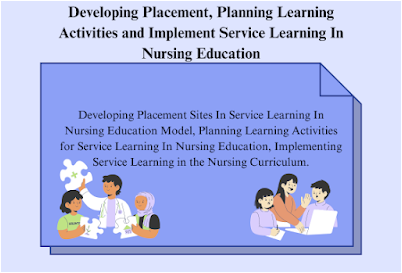The Developing Placement Planning Learning Activities and Implement Service Learning In Nursing Education. The ability to safely teach students, staff, or families is an important skill for all school nurses. Developing a lesson plan creates a clear “road map” that guides the lesson and documents the learning material.
The Developing Placement Planning Learning Activities and Implement Service Learning In Nursing Education
Developing effective internship planning and service-learning activities in nursing education requires a multifaceted approach that includes careful preparation, active participation, and reflection. These activities can be integrated into nursing programs through various strategies, such as simulations, case studies, and community projects.
Developing appropriate placement sites for service learning in nursing education is crucial for ensuring both student learning and community benefits. Anstee et al. (2008) proposed a six-stage model for incorporating service learning into an academic class:
- Establishing community collaboration
- Partnering in the classroom
- Student training
- Delivering the service
- Returning to the classroom
- Reporting to the stakeholders
To create successful placement sites, faculty must match the community organization’s mission with that of the educational institution. Conducting a community needs assessment and developing a resource inventory are vital steps in identifying where students are needed and which agencies can provide valuable learning opportunities. Community agency staff are essential in identifying pressing needs, which ensures that service learning projects align with real-world problems.
Once placement sites are selected, preceptors must be identified, and student orientation and initial meetings must be scheduled. Organizing these logistics before the semester starts enables students to begin their service learning projects promptly and finish within the semester timeframe. Faculty must also be prepared to address unexpected challenges, such as changes in community agency needs or dissatisfaction among students, which may require renegotiating expectations.
Planning Learning Activities for Service Learning in Nursing Education
Service learning is a dynamic pedagogy that provides nursing students with experiential opportunities to apply classroom knowledge to real-world community needs. Learning activities must align with the course objectives and content to ensure students’ learning is purposeful and effective (Phillips, Bolduc, & Gallo, 2013). Opportunities for service learning can arise from faculty members’ professional networks, colleagues, community agency personnel, or even students.
When planning service learning activities, legal and liability issues must be addressed, particularly when students are working off-campus. Faculty should seek legal counsel to ensure activities comply with institutional policies. Additionally, Institutional Review Board (IRB) approval may be required if students collect data as part of their service-learning project.
To engage students, faculty can use various campus resources such as student organizations, campus publicity channels, and interdisciplinary course announcements. It is important that learning activities relate directly to community needs and that students work with community partners to design sustainable programs.
The types of community agencies involved can range from healthcare facilities to social services, senior centers, and youth programs. Service learning tasks may include conducting health assessments, implementing new programs, or developing health education materials. Once students complete their service, a final meeting should be held with stakeholders to summarize the project and plan for sustainability.
Implementing Service Learning in the Nursing Curriculum
Service learning can be integrated into the nursing curriculum in various ways, from semester-long projects to courses focusing on underserved populations. In one model, students spend the first part of the semester in the classroom and the second part in a service learning placement. This approach allows students to apply theoretical knowledge in practical settings.
Examples of service learning projects include working with homeless children, senior citizens, teenage parents, and vulnerable populations at community centers. Nursing students may provide health screenings, educational handouts, or health assessments, collaborating with agencies like Habitat for Humanity or Head Start (Hales, 1997; Kulewicz, 2001).
In some cases, service learning has been integrated into faith-based curricula, where students work with agencies like Catholic Charities to provide care for economically disadvantaged individuals. These experiences deepen students’ understanding of community health challenges, enhance their empathy, and improve their ability to work with vulnerable populations (Brown, 2009).
Service learning experiences not only help students develop clinical and social skills but also offer opportunities for self-reflection on broader societal issues. For example, students may learn to reduce mental illness stigma in underserved communities, which in turn encourages community members to seek treatment (Brown, 2009). The integration of service learning into the curriculum offers nursing students a unique opportunity to blend academic learning with meaningful community service.
Read More:
https://nurseseducator.com/didactic-and-dialectic-teaching-rationale-for-team-based-learning/
https://nurseseducator.com/high-fidelity-simulation-use-in-nursing-education/
First NCLEX Exam Center In Pakistan From Lahore (Mall of Lahore) to the Global Nursing
Categories of Journals: W, X, Y and Z Category Journal In Nursing Education
AI in Healthcare Content Creation: A Double-Edged Sword and Scary
Social Links:
https://www.facebook.com/nurseseducator/
https://www.instagram.com/nurseseducator/
https://www.pinterest.com/NursesEducator/
https://www.linkedin.com/in/nurseseducator/
https://www.researchgate.net/profile/Afza-Lal-Din
https://scholar.google.com/citations?hl=en&user=F0XY9vQAAAAJ

3 thoughts on “Developing Placement Planning Learning Activities and Implement Service Learning In Nursing Education”